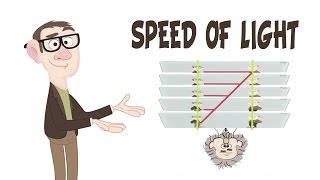(单词翻译:单击)
Light: it's the fastest thing in the universe,
光:宇宙中最快的东西,
but we can still measure its speed if we slow down the animation,
但我们依然有办法测量它的速度,如果我们把画面放慢,
we can analyze light's motion using a space-time diagram,
我们可以使用时空图来分析光的运动,
which takes a flipbook of animation panels, and turns them on their side.
就像从侧面来看一页页的手翻书。
In this lesson, we'll add the single experimental fact
在这堂课里,我们将补充一个实验事实,
that whenever anyone measures just how fast light moves, they get the same answer:
当任何人测量光的速度的时候,都会得到相同的结果:
299,792,458 meters every second, which means that when we draw light on our space-time diagram,
每秒299792458米,这意味着当我们把光画在时空图上时,
it's world line always has to appear at the same angle.
光的世界线必须总是呈现相同的角度。
But we saw previously that speed, or equivalently world line angles,
但是,我们之前看到,速度,即世界线的角度,
change when we look at things from other people's perspective.
会随着不同观察者的视角而改变。
To explore this contradiction, let's see what happens if I start moving while I stand still and shine the laser at Tom.
为了弄清这个矛盾,让我们来看看如下情况,如果我开始移动,而我站在这里朝着汤姆发射激光。
First, we'll need to construct the space-time diagram.
首先,我们需要构造时空图。
Yes, that means taking all of the different panels showing the different moments in time and stacking them up.
这意味着取出对应每一个时刻的每一帧图片,然后把它们叠在一起。
From the side, we see the world line of the laser light at its correct fixed angle, just as before.
从侧面我们看到,激光的世界线有着固定的、正确的角度,就和早先的一样。
So far, so good. But that space-time diagram represents Andrew's perspective.
目前为止一切顺利。但是这个时空图展示的是安德鲁的视角。
What does it look like to me?
从我的视角来看是什么样的呢?
In the last lesson, we showed how to get Tom's perspective
在上一课里,我们展示了如何得到汤姆的视角,
moving all the panels along a bit until his world line is completely vertical.
只需把所有的图片平移一点,直到汤姆的世界线完全垂直。
But look carefully at the light world line.
但是仔细看看光的世界线。
The rearrangement of the panels means it's now tilted over too far.
平移所有图片的话会使得光的世界线倾斜过度。
I'd measure light traveling faster than Andrew would.
我所测得的光速将会快于安德鲁所测得的。
But every experiment we've ever done, and we've tried very hard,
但是我们所做过的所有实验,我们所有的努力,
says that everyone measures light to have a fixed speed. So let's start again.
都表明光速是恒定的。让我们重新开始。
In the 1900s, a clever chap named Albert Einstein
在19世纪,有个聪明的家伙叫阿尔伯特·爱因斯坦,
worked out how to see things properly, from Tom's point of view, while still getting the speed of light right.
他想出了如何从汤姆的视角来正确地看待问题,而同时依然能得到正确的光速。
First, we need to glue together the separate panels into one solid block.
首先我们需要把分离的画面都粘合起来,粘成完整的一块。
This gives us our space-time, turning space and time into one smooth, continuous material.
于是我们有了时空,将时间和空间变成一整块平顺连续的材料。
And now, here is the trick.
现在,变戏法的时候到了。

What you do is stretch your block of space-time along the light world line,
你要做的是沿着世界线拉伸你的整块时空,
then squash it by the same amount, but at right angles to the light world line, and abracadabra!
然后在垂直于世界线的方向上同等数量地压缩时空,唵嘛呢叭咪吽!
Tom's world line has gone vertical, so this does represent the world from his point of view,
汤姆的世界线变得垂直了,所以这代表了他眼中的世界,
but most importantly, the light world line has never changed its angle,
但是最重要的是,光的世界线从未改变角度,
and so light will be measured by Tom going at the correct speed.
所以汤姆所测量的光速也是正确的光速。
This superb trick is known as a Lorentz transformation. Yeah, more than a trick.
这个杰出的戏法叫做洛伦兹变换。这可不是骗人的把戏。
Slice up the space-time into new panels and you have the physically correct animation.
重新将时空分割为一幅幅画面,你将得到物理上正确的动画。
I'm stationary in the car, everything else is coming past me
我静止坐在车里,所有东西都朝我移来并经过我身边,
and the speed of light works out to be that same fixed value that we know everyone measures.
而光速依然是那个恒定的速度,和所有人测量的光速一样。
On the other hand, something strange has happened.
而另一方面,有些奇怪的事情发生了。
The fence posts aren't spaced a meter apart anymore, and my mom will be worried that I look a bit thin.
围栏柱子的间隔不再是一米了,而我妈妈会担心我看起来瘦了。
But that's not fair. Why don't I get to look thin?
这不公平!为什么我看起来没瘦?
I thought physics was supposed to be the same for everyone.
我以为物理学对每个人都是一样的。
Yes, no, it is, and you do.
的确是一样的,你也看起来瘦了。
All that stretching and squashing of space-time
所有这些,时空的拉伸和压缩,
has just muddled together what we used to think of separately as space and time.
把我们之前认为的独立的时间和空间都混合到了一起。
This particular squashing effect is known as Lorentz contraction.
这个特别的压缩效应被称为洛伦兹收缩。
Okay, but I still don't look thin. No, yes, you do.
好吧,可是我依然看起来不瘦。不,你的确看起来瘦了。
Now that we know better about space-time, we should redraw what the scene looked like to me.
现在我们对时空有了更多的了解,我们应该重新画出我眼中的情形是怎么样的。
To you, I appear Lorentz contracted.
对你来说,我表现出洛伦兹收缩。
Oh but to you, I appear Lorentz contracted. Yes. Uh, well, at least it's fair.
而对你来说,我表现出了洛伦兹收缩。对,好吧,至少这是公平的。
And speaking of fairness, just as space gets muddled with time,
说到公平,不仅空间被时间搅浑,
time also gets muddled with space, in an effect known as time dilation.
时间也被空间搅浑,有个效应叫做时间膨胀。
No, at everyday speeds, such as Tom's car reaches,
虽然在日常的速度下,比如汤姆的车速,
actually all the effects are much, much smaller than we've illustrated them.
实际的效应非常非常地小,比我们刚才展示的要小得多。
Oh, yet, careful experiments, for instance watching the behavior of tiny particles
然而精密的实验,比如观察微小的粒子
whizzing around the Large Hadron Collider confirmed that the effects are real.
在大型强子对撞机里的运动,确认了这些效应是真实存在的。
And now that space-time is an experimentally confirmed part of reality, we can get a bit more ambitious.
既然现在时空已是被实验验证的事实,我们的野心可以更大一些。
What if we were to start playing with the material of space-time itself?
我们是否可以开始考虑时空本身的性质?
We'll find out all about that in the next animation.
我们会在下一个动画里找到答案。


